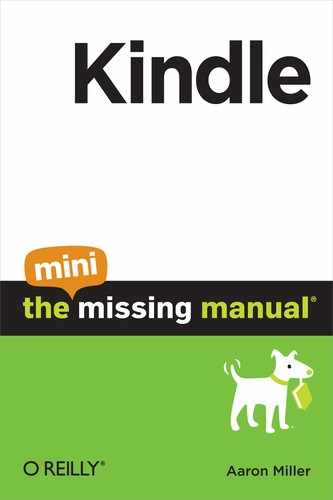Getting Stuff to Read
According to Amazon, the two gigabytes of storage hardwired into a Kindle 2 can hold over 1,500 books. Reading one book a week, it would take almost 29 years to read that many books. If you have a Kindle DX or a new Kindle 3, you’d need to spend over 67 years reading the 3,500 books it can hold. Of course, a lot of avid readers go through more than just one book every week, but 1,500 to 3,500 books is a lot of reading no matter how you look at it.
If for some crazy reason your life’s goal is to read as many books as your Kindle can hold, you’d better get started. So where do you get all these books to read? That’s the point of this chapter. Although you have the largest digital bookstore at your fingertips, it’s not the only way to get books onto your Kindle. This comes as a bit of a relief since those 1,500 books would cost you around $14,985 if you bought them all from Amazon.
The truth is pretty much any document you can read on your computer can be read on your Kindle, too. That is, if you have the right tools, patience, and know-how. So what are you waiting for? Time to get reading!
The Kindle Store
One wonders if Jeff Bezos, CEO of Amazon, saw the day coming when a person sitting on a park bench somewhere could browse through over 600,000 books using a device that weighs as much as a single paperback. Whether or not he saw this in the future, that future is here in the form of the Kindle bookstore.
You can either shop the Kindle store from your Kindle itself or from any device with a web browser. Because Amazon keeps track of everything on their servers, it doesn’t matter how you do it or what device you use. The really remarkable thing is that you don’t need a computer at all.
Shopping from your Kindle
No matter what you’re doing on your Kindle at the time, you get to the Kindle store by pressing the Menu button and selecting Shop in Kindle Store from the menu that appears. (A lot of the time, this option is underlined by default when you pull up the menu. If you haven’t gotten the message, Amazon really wants you to buy some books.) If you turned your wireless off, your Kindle gently reminds you that it needs the wireless on to shop the store and asks you if it can turn it on—a nice touch.
Once in the store, you go to a main page that looks like the one in Figure 2-1. You’ll first notice that the store sells more than just books—there’s also newspapers, magazines, and blogs. (What? You thought blogs were free? Think again!)
Amazon changes this main page pretty regularly, but the basic elements tend to stay the same. You get pointed to top selling books, both in the Kindle store and from the New York Times bestselling list. (Not all of the New York Times’ bestsellers are available on the Kindle, but those that are will be in this list.) Amazon also points you to a somewhat personalized set of recommended books based on your purchase history.

Figure 2-1: This is the main page for the Kindle store, as seen on your Kindle. While you can do plenty of browsing from here, notice the search box at the bottom. Just start typing and then press the ↵ key to go directly to what you’re trying to find.
You navigate the Kindle store with the little joystick. If the page looks too cluttered for your tastes, pressing the Menu button will give you a simplified list of most of what you see on the page (Figure 2-2).
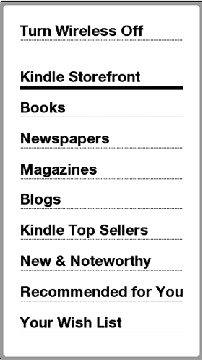
Figure 2-2: The Menu button reveals a decidedly less cluttered way to use the main page of the Kindle store.
Browsing for Books
Unless you have a specific book in mind, you can just start digging through all 600,000 titles available for the Kindle. From the main page of the store, select Books with the joystick. The screen fills with a list of categories and the number of titles that can be found within each category (Figure 2-3).
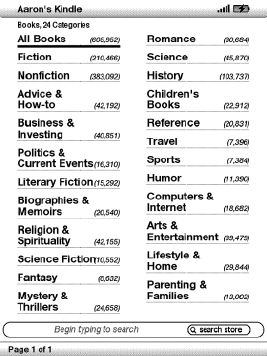
Figure 2-3: The list of categories is impressive, especially when you see how many titles are available in each category.
Once you select a category, like Fiction, a list of books, cover images and all, presents itself. Books are listed by bestselling. You can scroll up and down with the joystick to select a book and learn more about it. Press the Next Page button to see the next set of books in the list.
Fiction is obviously a gigantic category that lumps a lot of different genres all together. If it depresses you to think that you’ll have to click the Next Page button thousands of times to find books you’re interested, don’t despair. Tucked away in the top right corner of each category, your Kindle offers the View Categories option to browse by subcategory (Figure 2-4).

Figure 2-4: At the top of most category pages is the option to browse by subcategory. Also, you’ll have a breadcrumb trail showing you where you are in the category hierarchy.
Amazon even offers sub-subcategories in some cases. For example, under Mysteries and Thrillers, you’ll find General, Mystery, Police Procedurals, and Thrillers. Choose Thrillers, and you can get access to another five sub-sub-subcategories.
Note: All this category madness ends at some point. If there are no subcategories for your current selection, the View Subcategories option disappears from the top right corner of your screen.
In Figure 2-4, you’ll also notice that your Kindle helps you keep track of where you are in the category coal mine. The top left corner of your Kindle shows the current hierarchy of categories, like a trail of breadcrumbs showing where you’ve been. You can select any of the items in this list to jump straight to that category.
In any case, the Back button will take you back a step or more, depending on how many times you push it. (Remember, though, that it doesn’t take you back pages if you were using the Next Page button to dig into a list of books. That’s what the Prev Page button is for.)
Searching for Books
Offering the height of convenience, at any point in the Kindle store, you can just start typing on the keyboard to begin a search. The search box appears at the bottom of every page in the Kindle store, like the one you see in Figure 2-1. Once you’ve typed in a search, press the ↵ key on the keyboard or select Search Store with the joystick.
Whether you want to search by author, title, or anything else, just type in the term and give it a go. Because the Kindle store doesn’t distinguish between the different kinds of search terms, you’ll get all kinds of results. For example, typing in “green” gives you books with that word in the title as well as books written by authors named Green (Figure 2-5).
Tip: Make sure you search with complete words. For example, Graham Greene, spelled with an “e” at the end, doesn’t show up in the search results for “green”.
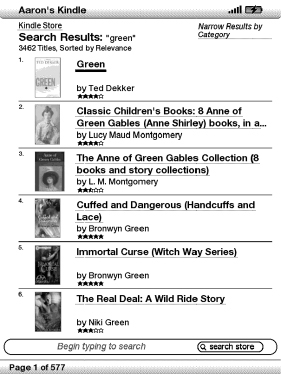
Figure 2-5: Have a thing for green? Here’s everything the Kindle store has to offer with the word green in it.
Once your search results appear, you move through the list of results with the Next Page button. Also, all search results give you a chance to narrow by category up in the top right corner of your screen.
Buying a Book
At any point while browsing, just select a book with the joystick to read more about it and, if you want the book, buy it. Every book gets its own page that gives you a lot of ways to learn more before you buy, including:
- A synopsis. Choose “more” if the book’s description doesn’t fit on the page.
- Customer reviews. You can read others’ reviews by selecting this item with the joystick.
- Details about its sales rank, length, publisher, publish date, and whether or not text-to-speech is enabled. (See “Using Text-to-Speech” on page 80 for more on text-to-speech.)
- Other books purchased by people who bought this book.
- Add to Wish List. This option is nice when you really are just browsing. (There’s one big advantage to the Kindle store: no need to shoo away nosy staff.)
- Try a Sample. A brief sample of the book, usually the first dozen or so pages, will automatically download to your Kindle.
Try a Sample deserves a little more description. Basically, Amazon gives you a little version of what you can do when you visit your local bookstore but without the guilt of reading a book you ought to be paying for. When you try a sample of a book, your Kindle gets a selection from the book, usually the beginning. Samples are all marked as such in your book list. If you decide to buy the book after reading the sample, the end of every sample gives you a purchase link you can select with the joystick.
Note: Any time you buy a book, you don’t need to enter any payment information. Amazon will bill you using the default credit card information you entered into your Amazon account.
If you want the book, just choose the huge, impossible-to-miss Buy button on the book’s page. Your download begins immediately. In fact, there’s no confirmation step, so be sure that you mean it when you choose Buy.
Tip: Although Amazon doesn’t ask you, “Are you sure?” when you click to buy a book on your Kindle, the screen that comes after your purchase does give you the option to cancel the transaction. If you dismiss that screen but still want to cancel your purchase, you’ll need to contact Amazon customer support.
Shopping from a Web Browser
You can also use any web browser to browse, search for, and buy books for your Kindle. In fact, you may find this approach simpler and quicker than the endless button presses needed to navigate the store through your Kindle.
Go to http://www.amazon.com/kindle to begin searching for and buying books. From this page, anything you type into the search box will give you access to the same books you can access from your Kindle.
When buying a book for your Kindle from a browser, you need to keep a few things in mind:
- Make sure you’re buying the Kindle version. Amazon often has hardback, paperback, and even audio book versions of a single title. You can be sure you’re getting the Kindle version by clicking the Kindle version in the part of the web page that looks like Figure 2-6. You don’t want the nasty surprise of a $25 hardback copy showing up at your door a week later.

Figure 2-6: Make sure you’re buying the Kindle version of a book by selecting the Kindle version from this box on a book’s page.
- Make sure you send the book to your Kindle. If you’ve enabled any other devices for reading Kindle books (“Reading Your Kindle Library on Your Computer or Mobile Device” on page 86), your purchase will go to whatever device you selected from the dropdown menu under the Buy Now button (Figure 2-7). This menu generally defaults to your Kindle.
- You can add books to your Wish List from a browser. If you’re not sure you want to buy a book, you can always add it to your Wish List using the button you see in Figure 2-7. This Wish List is available on your Kindle when you’re browsing the Kindle store. (Access your Wish List quickly using the menu you see in Figure 2-2.)
- You can download samples from a browser, too. Using the dropdown menu and the Send Sample Now button, you can start reading a sample on your Kindle right away (Figure 2-7).
Purchases from a web browser usually start downloading to your Kindle within a minute or two of buying them. Of course, if the wireless is off on your Kindle, the books won’t show up until you turn it back on.
Add Your Own Documents
The magic of the Kindle would be decidedly less magical if all you could read were Amazon’s wares. Luckily, Amazon didn’t take its cue from the razor manufacturers who sell you the razor for cheap, only to charge a bundle for the blades. Conceivably, you could buy a Kindle and never read a single book sold by Amazon. That’s because adding your own documents to your Kindle is pretty easy.
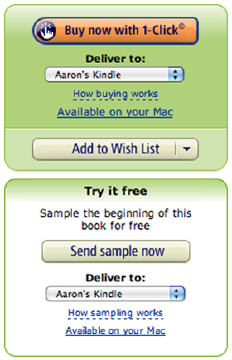
Figure 2-7: From this box on the right-hand side of any book’s page, you can buy a book, add it to your Wish List, or download just a sample to your Kindle.
Documents You Can Read on Your Kindle
When it all boils down to it, your Kindle really only knows how to display four kinds of documents:
- Amazon’s proprietary format, which on your computer would end with .AZW,
- Plain text files, which end with .TXT,
- Mobipocket files, which are just another eBook format that end with .MOBI or .PRC, and
- PDF files, which end with .PDF (of course).
Note: Mobipocket files sometimes come with some sort of file protection that limits where you can read them. Protected Mobipocket files won’t work on your Kindle.
Don’t let this short list disappoint you. The truth is, as long as you’re patient and don’t mind occasionally awkward formatting, pretty much any text you have in electronic format can eventually make it onto your Kindle.
Converting and Uploading Documents: Two Approaches
Pretend your nephew is a budding author. He’s drafted the next great American novel, Robot Horrors from the 6th Dimension, and wants you to read it. For some crazy reason, you say yes. That’s when he tells you the book is 1,034 pages long.
Faced with the prospect of either lugging around two reams of paper or reading this monstrosity on a laptop screen, you bless the day that you bought your Kindle. Knowing that you can somehow read Robot Horrors on your Kindle, there are two approaches you can take.
Approach 1: Convert and Upload via WhisperNet
As part of the WhisperNet service, your Kindle comes with its own email address. This isn’t so your Kindle can keep in touch with its Kindle friends from back at the factory. Amazon offers this email address as a simple, convenient way to get your own documents wirelessly to your Kindle. (But it will cost you! When you use WhisperNet to send documents to your Kindle, Amazon charges a small fee explained in the sidebar When Free Isn’t Free: Personal Documents
Through WhisperNet.)
When you first bought your Kindle and set it up, you chose a name for this email address. If you forgot the name or want to change it, go to http://www.amazon.com/manageyourkindle. From there, find “Your Kindle(s)” and you’ll see your Kindle’s email address listed. (It will end in “@kindle.com”.) If you want to change that address, choose Edit Info. Anything you choose will work as long as some other Kindle owner isn’t already using it.
Once you have your email address ready, sending documents to your Kindle is simply a matter of emailing them as attachments to your Kindle email address.
Note: Only email addresses you authorize can send documents to your Kindle. This is true for documents you or anyone else send. To add emails to your approved email list, visit http://www.amazon.com/manageyourkindle.
If your document isn’t one of the four file types the Kindle can read, Amazon will automatically convert it to their proprietary format before pushing the file on to your Kindle. (PDFs are a notable exception to this behavior. See the box below.)
Before you send off any old file, however, you need to know that any old file can’t necessarily be converted. Amazon’s conversion service supports the following files: Microsoft Word (.DOC), Structured HTML (.HTML, .HTM), Rich Text Files (.RTF), and PDFs (.PDF). If your file doesn’t meet these requirements, like an old WordPerfect file, you might get what you want by simply copying and pasting the text into a Word document.
Tip: If you’re using a new version of Microsoft Word, you might be saving files with the .DOCX extension instead of the older .DOC format. Amazon only supports .DOCX files on an “experimental” basis. If these files aren’t working right on your Kindle, open those files in Word and use the Save As… option from the File menu to save them as .DOC files.
Amazon even lets you upload pictures to your Kindle (in the form of jpeg, gif, or png files), but this isn’t exactly a vibrant way to display your pictures, unless you consider newspaper-quality black and white to be vibrant.
Also consider the size of your document. A lot of email services limit the file size of email attachments, often to a maximum of ten megabytes. It doesn’t take a whole lot for a PDF or Word file to exceed that (particularly one that is 1,034 pages long). If your email service limits your ability to send large attachments, you may be relegated to Approach 2, which you can read below.
Once you’ve sent the file, it may take several minutes before it shows up on your Kindle. If something went wrong, it might turn out that nothing happens. If your document never showed up, try sending it from a different email address. (Make sure you’ve approved that email address first at http://www.amazon.com/manageyourkindle.) If that doesn’t work, try saving the file as a different, supported file type. (Most word processing software lets you choose from a range of file types using the Save As… option under the File menu.)
If all goes well, you can start reading Robot Horrors from the comfort of your own Kindle right away. Hey, the sooner you start, the sooner you’re done.
Approach 2a: Convert from Your Computer
As you read above, WhisperNet is convenient, but has its limitations. You can’t send really big files via email and you’ll pay Amazon a fee for the files you do send. If these constraints turn you off to WhisperNet, you do have the alternative of using your computer.
All the same basic rules apply here. The Kindle still only supports the four file types above. Any other document types will have to be converted first. You also have to decide if you want your PDFs converted or not.
You can convert your files that need converting in two ways. First, you can use Amazon’s conversion service for free. To do this:
1. Send the file as an email attachment to [email protected]. (Note the word “free” just before “kindle.com”.) If you want to convert a PDF, be sure to type “convert” in the subject line. A few seconds to a few minutes later, an email will arrive to your computer with the converted document.
2. In the return email, click on the document link. This will download the file to your computer. It should have the same file name as the file you sent, except that it will end in .AZW.
3. Upload the document to your Kindle via USB using the instructions below.
Of course, this approach still faces the problem you get with huge email attachments. If your document is too big to send via email, then you’ll need to convert it on your computer using some third-party software.
Without going into detail, here are three free, third-party programs that can convert most documents into a format Kindles can read.
- MobiPocket Creator. (http://www.mobipocket.com/en/DownloadSoft/ProductDetailsCreator.asp) Converts files to the .MOBI format supported by your Kindle. Only works on computers running Microsoft Windows.
- Stanza Desktop. (http://www.lexcycle.com/desktop) Converts into all major eBook formats, including Amazon’s .AZW. Works on Windows and Macintosh Computers.
- Calibre. (http://calibre-ebook.com/download) An open-source eBook reader and converter that will convert into all major eBook formats, including Amazon’s .AZW. Works on Windows, Macintosh, and Linux computers.
These programs convert documents with varying levels of success, but generally perform well. Once you’ve used one of these programs to convert your document, the time has come to upload it to your Kindle via its USB connection.
Approach 2b: Upload from Your Computer
The cable that came with your Kindle works not only to charge your device, but also allows it to act as an external drive for your computer. Once connected, you’ll be able to drag and drop any kind of file that your Kindle supports for later reading. Here are the steps for both Macintosh and Windows computers.
1. Connect your Kindle to your Mac or PC using the Kindle’s USB cable. An external hard drive icon called Kindle will appear (Figure 2-8). On a Mac, the icon appears on the Desktop. On a Windows computer, it appears under My Computer.
2. Double-click the icon to reveal some folders. (Don’t fiddle around in here too much unless you know what you’re doing. You might accidentally delete important documents or files. Read more about these folders at the end of Chapter 3 in the sidebar The Kindle Files.)
3. On your Mac or PC, locate the file you want to read. Drag and drop it into the “documents” folder on your Kindle. (Don’t confuse this with the Documents folder on your Mac or PC.)
4. Eject the Kindle disk before disconnecting it from your computer. On a PC, right-click on the Kindle icon and choose Eject. On a Mac, select the Kindle icon and press @cmd-E or simply drag it to the trash.
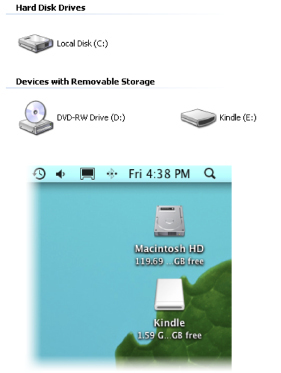
Figure 2-8: When you connect your Kindle to your computer, PC (top) or Mac (bottom), it shows up like an external hard drive.
Once you’ve added the file to your Kindle, it shows up in your book list. So settle in and get started with your nephew’s masterpiece. It’s gonna take a while.
Get Free Books
Luckily, your selection of free books for the Kindle is not limited to the fractured prose of wannabe-author relatives. In fact, there are so many free books out there that you can easily read nothing but free books for the rest of your life. Are they books you’d actually enjoy reading? Well, that’s another thing, but you shouldn’t have any trouble at all finding free books that you’ll enjoy.
Free Books from Amazon
Yes, the same Amazon that makes money selling books also offers you free ones. Some of these books are public domain books while others are free only for a limited time as promotional offers.
Unfortunately, there’s no easy way to browse free books from your Kindle, but if you visit Amazon’s website and enter the Kindle store, there’s a link on the left-hand side called Free Book Collections.
Free Books from the Internet
In the true free spirit of the Internet, where else would you go looking for free books? Well, the Internet has a lot of free books. In fact, we’re talking about millions of free books. All of them are offered in a format that the Kindle either natively supports or that can easily be translated for the Kindle.
Even more exciting, most of these websites can be visited from the experimental web browser built into your Kindle (Chapter 6). That means you can visit these websites and download eBooks directly to your Kindle, no computer required. Oh yeah, and Amazon doesn’t tack on its download fee.
- Mobipocket (http://www.mobipocket.com/freebooks/) has been selling eBooks as long as anyone. Their books work natively on the Kindle.
Note: Although the Mobipocket file format works natively on the Kindle, some .MOBI or .PRC files have been protected, limiting them to a particular device. The protected version of these books won’t work on your Kindle.
- Internet Archive (http://www.archive.org/details/texts), the bastion of the public domain, offers over two million eBooks. Most of these are also out-of-print.
- ManyBooks (http://manybooks.net/) only offers free books. The site administrator runs ManyBooks as a service to the Internet at large.
- FeedBooks (http://www.feedbooks.com/help/kindle) offers many public domain and original books for free, but also has a very creative custom eBook for the Kindle that is filled with links to its catalog. If you download this catalog book, you can browse through it just as you would read a book on your Kindle, but as you read you can use your joystick to select and download the books it lists. Very cool idea.
- Freekindlebooks.org (http://freekindlebooks.org/) has a simple, straightforward website full of free books that you can browse by category.
- Google Books (http://books.google.com/) has a controversial, albeit short, history because Google has been scanning thousands and thousands of books and storing them in their databases, whether they are in the public domain or not. That said, all the books in Google’s repository that are public domain can be downloaded as ePub books. (ePub books don’t work natively on the Kindle, but can easily be converted using one of the computer programs listed earlier.)
Periodicals
Imagine getting the New York Times or Wall Street Journal magically whisked to your bedside table every morning. Without even leaving your bed, you reach over, grab the paper, and dig in to the day’s news from under the warmth of your covers. No wandering out in a robe each morning, hoping the neighbors aren’t out yet. No worrying about newspaper boys with bad aim.
The Kindle makes this possible thanks to the Kindle store and WhisperNet. In fact, it makes it better. Because you can read newspapers and magazines on your Kindle, it means no messy newsprint on your fingers and no stacks of paper to recycle. If only it could do breakfast, too.
Although you can get free books to your Kindle from places other than the Kindle store, subscriptions have to come from Amazon. You can buy them either through the Kindle store or from a computer with a web browser. Prices and frequency of delivery vary with each publication. Some are daily, like the New York Times, while others only come once a month, like many magazines.
Subscribing to a Newspaper or Magazine
From your Kindle, go to the Kindle store by pressing Menu and selecting Shop in Kindle Store. This takes you to the main page you saw in Figure 2-1. From there, select either newspapers or magazines, depending on what you want to start reading.
At this writing, the Kindle store has over 130 newspapers (more than 70 from the US, with the rest international) and over 60 magazine titles. This isn’t an exhaustive collection of periodicals, so you probably won’t find Basketweaving Enthusiast in the Kindle store. Still, many popular titles are available, so you’ll probably find something you like. Figure 2-9 shows the top selling US newspapers at the time of this writing.
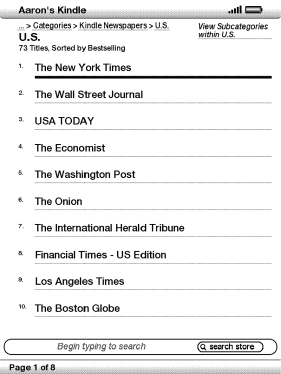
Figure 2-9: These are the top selling US newspapers in the Kindle store. (Yes, Amazon considers the Onion a newspaper.) Notice that there are subcategories for US newspapers.
The store page for a periodical is a bit like the store page for a book (Figure 2-10). You’ll notice that you can read other people’s reviews and add a newspaper or magazine to your Wish List. The most striking thing is the subscribe button for two reasons. First, it’s freaking huge. Second, it offers you a free 14-day trial. Every periodical comes with this free, two-week trial period. If you decide within the limits of the trial that you don’t like a subscription, you can cancel it easily. (Keep reading to learn how.)
Tip: If you don’t want to subscribe, you can buy just a single issue. Notice, for example, in Figure 2-10 that a single issue of the New York Times will cost you less than a buck.
If you want to try out a newspaper, but you’re afraid you’ll forget to cancel your free trial, buying just one issue is a great, low cost way to check it out.
If you want to sign up for a periodical from the Amazon website instead of from your Kindle, it basically works the same as buying a Kindle book. Just follow the directions in Shopping from a Web Browser found earlier in this chapter.
Unsubscribing from a Newspaper or Magazine
Whether you’re still in the 14-day trial period, or you’ve been reading a magazine or newspaper for months now, you can cancel your Kindle subscription by visiting http://amazon.com/manageyourkindle. Scroll down the web page until you see Your Active Kindle Subscription. Next to each periodical is a link that says Cancel Subscription.
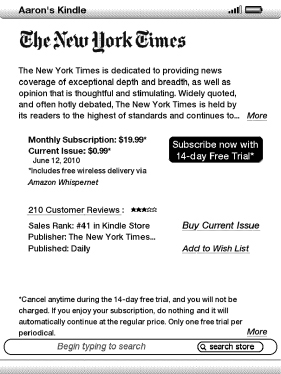
Figure 2-10: Signing up for the New York Times from your Kindle is a piece of cake, especially because that subscribe button is so dang big.
Clicking that link leads to a smaller window asking you to confirm your cancellation, and a chance to explain why you’re doing it (Figure 2-11). Don’t worry, you don’t have to explain yourself to Amazon. You can just click the Cancel Subscription button and move on with your life.
Note: If you’re still in the middle of your trial period and decide to cancel, you won’t get another free trial. Amazon only allows for one free trial per periodical.
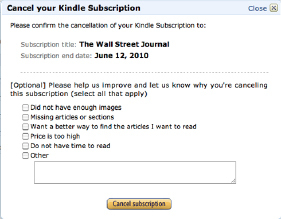
Figure 2-11: Amazon shows you this extra message when you try to cancel a subscription. Yes, you’re sure you want to cancel your subscription and no, you don’t have to tell them why. Just click Cancel Subscription.
Blogs
So this part is a little crazy. Blogs are basically free. Go visit a blog in any web browser from any computer, and you’re probably (with 99% probability) not going to have to pay a subscription fee. This is because most blogs get the financial support from advertising, or the authors just do it for some nonfinancial reason.
Not so on the Kindle. Amazon had the big idea of syndicating blogs for the Kindle. Blog authors liked the idea because they could sign up with Amazon, offer their blogs on the Kindle, and get a little cash out of it.
If you agree that this is a bit crazy, since you can read all of these blogs for free, then just keep reading whatever else you love reading with Kindle. There’s no more reason to dwell on the topic.
Note: If you started reading this part and found yourself asking, “What the heck is a blog?” then all you really need to know is that it’s a kind of online publishing for the masses. Just about anyone out there can start (and probably has started) their own blog and put their writings out on the Internet for the whole world to read.
Of course, with the income from advertising on web pages, some people make a living out of blogging, so it’s not all boring navel-gazing. (But a lot of it is.)
Of course, if you love the idea of reading your favorite blogs on your Kindle, having each article automatically sent to your Kindle, then you’re in luck. As long as your favorite blogs are set up to work on your Kindle.
You can browse the entire list of available blogs from the Kindle store page on your Kindle or through a web browser. Signing up for a blog subscription basically works just like a magazine or newspaper (Figure 2-12).
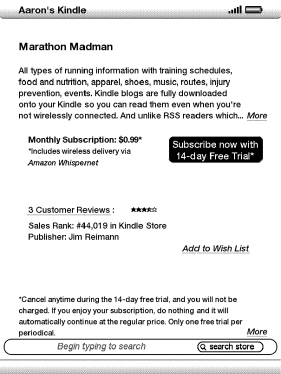
Figure 2-12: Signing up for a blog subscription works just like signing up for a newspaper or magazine, free trial and all.
There are two minor differences between blogs and periodicals, though:
- Blogs are really cheap. Usually just a buck or two a month. This redeems (somewhat) the crazy idea of charging for them in the first place. (Of course, some magazine subscriptions are that cheap, too.)
- Blogs come to your Kindle in “issues”, just like the New York Times comes in print or to your Kindle. But the web browser version of blog doesn’t work that way. Blogs usually update just one article at a time. This issue-by-issue distribution model means you’re not going to get the latest blog article pushed to your Kindle the same time it shows up on the web.
If you want to cancel a blog subscription, it works the same way as canceling a newspaper or magazine subscription on your Kindle. See the instructions above, Unsubscribing from a Newspaper or Magazine.
